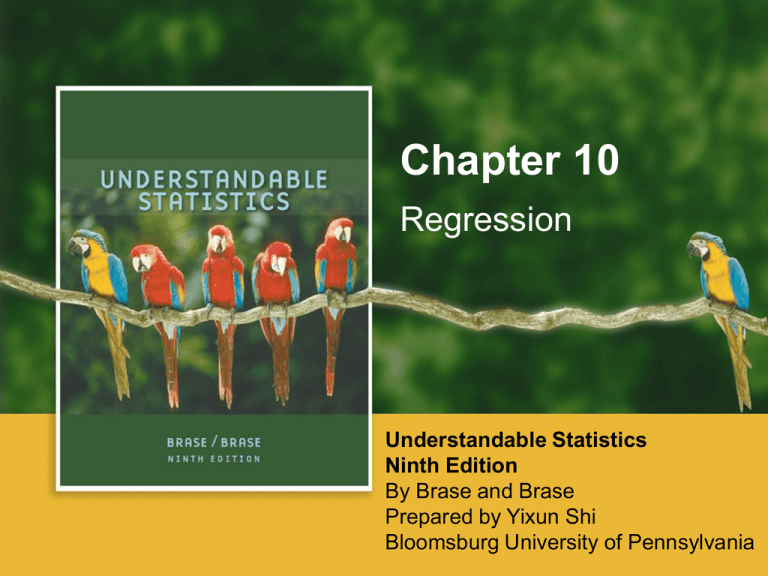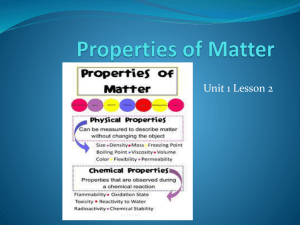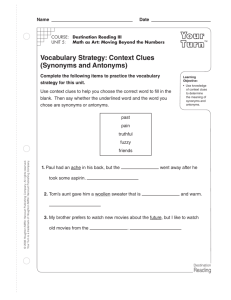
Chapter 10
Regression
Understandable Statistics
Ninth Edition
By Brase and Brase
Prepared by Yixun Shi
Bloomsburg University of Pennsylvania
Scatter Diagrams
• A graph in which pairs of points, (x, y), are
plotted with x on the horizontal axis and y on
the vertical axis.
• The explanatory variable is x.
• The response variable is y.
• One goal of plotting paired data is to determine
if there is a linear relationship between x and y.
Copyright © Houghton Mifflin Harcourt Publishing Company. All rights reserved.
10 | 2
Finding the Best Fitting Line
• One goal of data analysis is to find a
mathematical equation that “best” represents
the data.
• For our purposes, “best” means the line that
comes closest to each point on the scatter
diagram.
Copyright © Houghton Mifflin Harcourt Publishing Company. All rights reserved.
10 | 3
Not All Relationships are Linear
Copyright © Houghton Mifflin Harcourt Publishing Company. All rights reserved.
10 | 4
Correlation Strength
• Correlation is a measure of the linear
relationship between two quantitative variables.
• If the points lie exactly on a straight line, we say
there is perfect correlation.
• As the strength of the relationship decreases,
the correlation moves from perfect to strong to
moderate to weak.
Copyright © Houghton Mifflin Harcourt Publishing Company. All rights reserved.
10 | 5
Correlation
• If the response variable, y, tends to increase as
the explanatory variable, x, increases, the
variables have positive correlation.
• If the response variable, y, tends to decrease as
the explanatory variable, x, increases, the
variables have negative correlation.
Copyright © Houghton Mifflin Harcourt Publishing Company. All rights reserved.
10 | 6
Correlation Examples
Copyright © Houghton Mifflin Harcourt Publishing Company. All rights reserved.
10 | 7
Correlation Coefficient
• The mathematical measurement that describes
the correlation is called the sample correlation
coefficient.
• Denoted by r.
Copyright © Houghton Mifflin Harcourt Publishing Company. All rights reserved.
10 | 8
Correlation Coefficient Features
1) r has no units.
2) -1 ≤ r ≤ 1
3) Positive values of r indicate a positive
relationship between x and y (likewise for
negative values).
4) r = 0 indicates no linear relationship.
5) Switching the explanatory variable and
response variable does not change r.
6) Changing the units of the variables does not
change r.
Copyright © Houghton Mifflin Harcourt Publishing Company. All rights reserved.
10 | 9
r=0
Copyright © Houghton Mifflin Harcourt Publishing Company. All rights reserved.
10 | 10
r = 1 or r = -1
Copyright © Houghton Mifflin Harcourt Publishing Company. All rights reserved.
10 | 11
0<r<1
Copyright © Houghton Mifflin Harcourt Publishing Company. All rights reserved.
10 | 12
-1 < r < 0
Copyright © Houghton Mifflin Harcourt Publishing Company. All rights reserved.
10 | 13
Developing a Formula for r
Copyright © Houghton Mifflin Harcourt Publishing Company. All rights reserved.
10 | 14
Developing a Formula for r
Copyright © Houghton Mifflin Harcourt Publishing Company. All rights reserved.
10 | 15
A Computational Formula for r
Copyright © Houghton Mifflin Harcourt Publishing Company. All rights reserved.
10 | 16
Critical Thinking:
Population vs. Sample Correlation
• Beware: high correlations do not imply a cause
and effect relationship between the explanatory
and response variables!!
Copyright © Houghton Mifflin Harcourt Publishing Company. All rights reserved.
10 | 17
Critical Thinking: Lurking Variables
• A lurking variable is neither the explanatory
variable nor the response variable.
• Beware: lurking variables may be responsible
for the evident changes in x and y.
Copyright © Houghton Mifflin Harcourt Publishing Company. All rights reserved.
10 | 18
Correlations Between Averages
• If the two variables of interest are averages
rather than raw data values, the correlation
between the averages will tend to be higher!
Copyright © Houghton Mifflin Harcourt Publishing Company. All rights reserved.
10 | 19
Linear Regression
• When we are in the “paired-data” setting:
– Do the data points have a linear
relationship?
– Can we find an equation for the best fitting
line?
– Can we predict the value of the response
variable for a new value of the predictor
variable?
– What fractional part of the variability in y is
associated with the variability in x?
Copyright © Houghton Mifflin Harcourt Publishing Company. All rights reserved.
10 | 20
Least-Squares Criterion
• The line that we fit to the data will be such that
the sum of the squared distances from the line
will be minimized.
• Let d = the vertical distance from any data point
to the regression line.
Copyright © Houghton Mifflin Harcourt Publishing Company. All rights reserved.
10 | 21
Least-Squares Criterion
Copyright © Houghton Mifflin Harcourt Publishing Company. All rights reserved.
10 | 22
Least-Squares Line
yˆ a bx
• a is the y-intercept.
• b is the slope.
Copyright © Houghton Mifflin Harcourt Publishing Company. All rights reserved.
10 | 23
Finding the Regression Equation
Copyright © Houghton Mifflin Harcourt Publishing Company. All rights reserved.
10 | 24
Finding the Regression Equation
Copyright © Houghton Mifflin Harcourt Publishing Company. All rights reserved.
10 | 25
Using the Regression Equation
• The point ( x , y ) is always on the least-squares
line.
• Also, the slope tells us that if we increase the
explanatory variable by one unit, the response
variable will change by the slope (increase or
decrease, depending on the sign of the slope).
Copyright © Houghton Mifflin Harcourt Publishing Company. All rights reserved.
10 | 26
Critical Thinking: Making Predictions
• We can simply plug in x values into the
regression equation to calculate y values.
• Extrapolation can result in unreliable
predictions.
Copyright © Houghton Mifflin Harcourt Publishing Company. All rights reserved.
10 | 27
Coefficient of Determination
• Another way to gauge the fit of the regression
equation is to calculate the coefficient of
determination, r2.
• We can view the mean of y as a baseline for all
the y values.
• Then:
Copyright © Houghton Mifflin Harcourt Publishing Company. All rights reserved.
10 | 28
Copyright © Houghton Mifflin Harcourt Publishing Company. All rights reserved.
10 | 29
Coefficient of Determination
We algebraically manipulate the above equation to obtain:
Copyright © Houghton Mifflin Harcourt Publishing Company. All rights reserved.
10 | 30
Coefficient of Determination
Thus, r2 is the measure of the total variability in y that is explained by
the regression on x.
Copyright © Houghton Mifflin Harcourt Publishing Company. All rights reserved.
10 | 31
Coefficient of Determination
Copyright © Houghton Mifflin Harcourt Publishing Company. All rights reserved.
10 | 32
Inferences on the Regression Equation
• We can make inferences about the population
correlation coefficient, ρ, and the population
regression line slope, β.
Copyright © Houghton Mifflin Harcourt Publishing Company. All rights reserved.
10 | 33
Inferences on the Regression Equation
• Inference requirements:
– The set of ordered pairs (x, y) constitutes a
random sample from all ordered pairs in the
population.
– For each fixed value of x, y has a normal
distribution.
– All distributions for all y values have equal
variance and a mean that lies on the
regression equation.
Copyright © Houghton Mifflin Harcourt Publishing Company. All rights reserved.
10 | 34
Testing the Correlation Coefficient
Copyright © Houghton Mifflin Harcourt Publishing Company. All rights reserved.
10 | 35
Testing the Correlation Coefficient
• We convert to a Student’s t distribution.
• The sample size must be ≥ 3.
Copyright © Houghton Mifflin Harcourt Publishing Company. All rights reserved.
10 | 36
Testing Procedure
Copyright © Houghton Mifflin Harcourt Publishing Company. All rights reserved.
10 | 37
Standard Error of Estimate
• As the points get closer to the regression line,
Se decreases.
• If all the points lie exactly on the line, Se will be
zero.
Copyright © Houghton Mifflin Harcourt Publishing Company. All rights reserved.
10 | 38
Computational Formula For Se
Copyright © Houghton Mifflin Harcourt Publishing Company. All rights reserved.
10 | 39
Confidence Intervals for y
• The population regression line:
y = α + βx + ε
Where ε is random error
• Because of ε, for each x value there is a
corresponding distribution for y.
• Each y distribution has the same standard
deviation, estimated by Se.
• Each y distribution is centered on the
regression line.
Copyright © Houghton Mifflin Harcourt Publishing Company. All rights reserved.
10 | 40
Confidence Intervals for Predicted y
Copyright © Houghton Mifflin Harcourt Publishing Company. All rights reserved.
10 | 41
Confidence Intervals for Predicted y
Copyright © Houghton Mifflin Harcourt Publishing Company. All rights reserved.
10 | 42
Confidence Intervals for Predicted y
• The confidence intervals will be narrower near
the mean of x.
• The confidence intervals will be wider near the
extreme values of x.
Copyright © Houghton Mifflin Harcourt Publishing Company. All rights reserved.
10 | 43
Confidence Intervals for Predicted y
Copyright © Houghton Mifflin Harcourt Publishing Company. All rights reserved.
10 | 44
Inferences About Slope β
• Recall the population regression equation: y = α
+ βx + ε
• Let Se be the standard error of estimate from
the sample.
Copyright © Houghton Mifflin Harcourt Publishing Company. All rights reserved.
10 | 45
Inferences About Slope β
• Has a Student’s t distribution with n – 2 degrees
of freedom.
Copyright © Houghton Mifflin Harcourt Publishing Company. All rights reserved.
10 | 46
Testing β
Copyright © Houghton Mifflin Harcourt Publishing Company. All rights reserved.
10 | 47
Finding a Confidence Interval for β
Copyright © Houghton Mifflin Harcourt Publishing Company. All rights reserved.
10 | 48
Multiple Regression
• In practice, most predictions will improve if we
consider additional data.
• Statistically, this means adding predictor
variables to our regression techniques.
Copyright © Houghton Mifflin Harcourt Publishing Company. All rights reserved.
10 | 49
Multiple Regression Terminology
• y is the response variable.
• x1 … xk are explanatory variables.
• b0 … bk are coefficients.
Copyright © Houghton Mifflin Harcourt Publishing Company. All rights reserved.
10 | 50
Regression Models –
A mathematical package that includes the following:
1) A collection of variables, one of which is the
response, and the rest are predictors.
2) A collection of numerical values associated with
the given variables.
3) Using software and the above numerical
values, construct a least-squares regression
equation.
Copyright © Houghton Mifflin Harcourt Publishing Company. All rights reserved.
10 | 51
Regression Models –
A mathematical package that includes the following:
4) The model includes information about the
variables, coefficients of the equation, and
various “goodness of fit” measures.
5) The model allows the user to make predictions
and build confidence intervals for various
components of the equation.
Copyright © Houghton Mifflin Harcourt Publishing Company. All rights reserved.
10 | 52
Coefficient of Multiple Determination
• How well does our equation fit the data?
– Just as in linear regression, computer output
will provide r2 .
• r2 is a measure of the amount of
variability in y that is explained by the
regression on all of the x variables.
Copyright © Houghton Mifflin Harcourt Publishing Company. All rights reserved.
10 | 53
Predictions in the
Multiple Regression Case
• Similar to the techniques described for linear
regression, we can “plug in” values for all of the
x variables and compute a predicted y value.
– Predicting y for any x values outside the xrange is extrapolation, and the results will be
unreliable.
Copyright © Houghton Mifflin Harcourt Publishing Company. All rights reserved.
10 | 54
Testing a Coefficient for Significance
• At times, one or more of the predictor variables
may not be helpful in determining y.
• Using software, we can test any or all of the x
variables for statistical significance.
Copyright © Houghton Mifflin Harcourt Publishing Company. All rights reserved.
10 | 55
Testing a Coefficient for Significance
• The hypotheses will be:
H0: βi = 0
H1: βi ≠ 0
for the ith coefficient in the model.
• If we fail to reject the null hypothesis for a given
coefficient, we may consider removing that
predictor from the model.
Copyright © Houghton Mifflin Harcourt Publishing Company. All rights reserved.
10 | 56
Confidence Intervals for Coefficients
• As in the linear case, software can provide
confidence intervals for any βi in the model.
Copyright © Houghton Mifflin Harcourt Publishing Company. All rights reserved.
10 | 57



